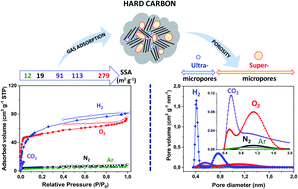Hard carbon porosity revealed by the adsorption of multiple gas probe molecules (N2, Ar, CO2, O2 and H2)†
Abstract
The porosity of hard carbon materials is usually assessed by nitrogen adsorption, which can lead to apparently non-porous materials and misleading interpretation of sodium storage in Na-ion batteries. Herein, a series of complementary gases (N2, Ar, CO2, O2 and H2) were used to reveal the porosity of hard carbons. In particular, unconventional gases, such as H2 and O2, showed significantly higher adsorbed volumes and specific surface areas than N2, Ar or even CO2. Notably, O2 was the only gas able to access both the ultramicropores (d < 0.7 nm) and supermicropores (0.7 < d < 2.0).



 Please wait while we load your content...
Please wait while we load your content...